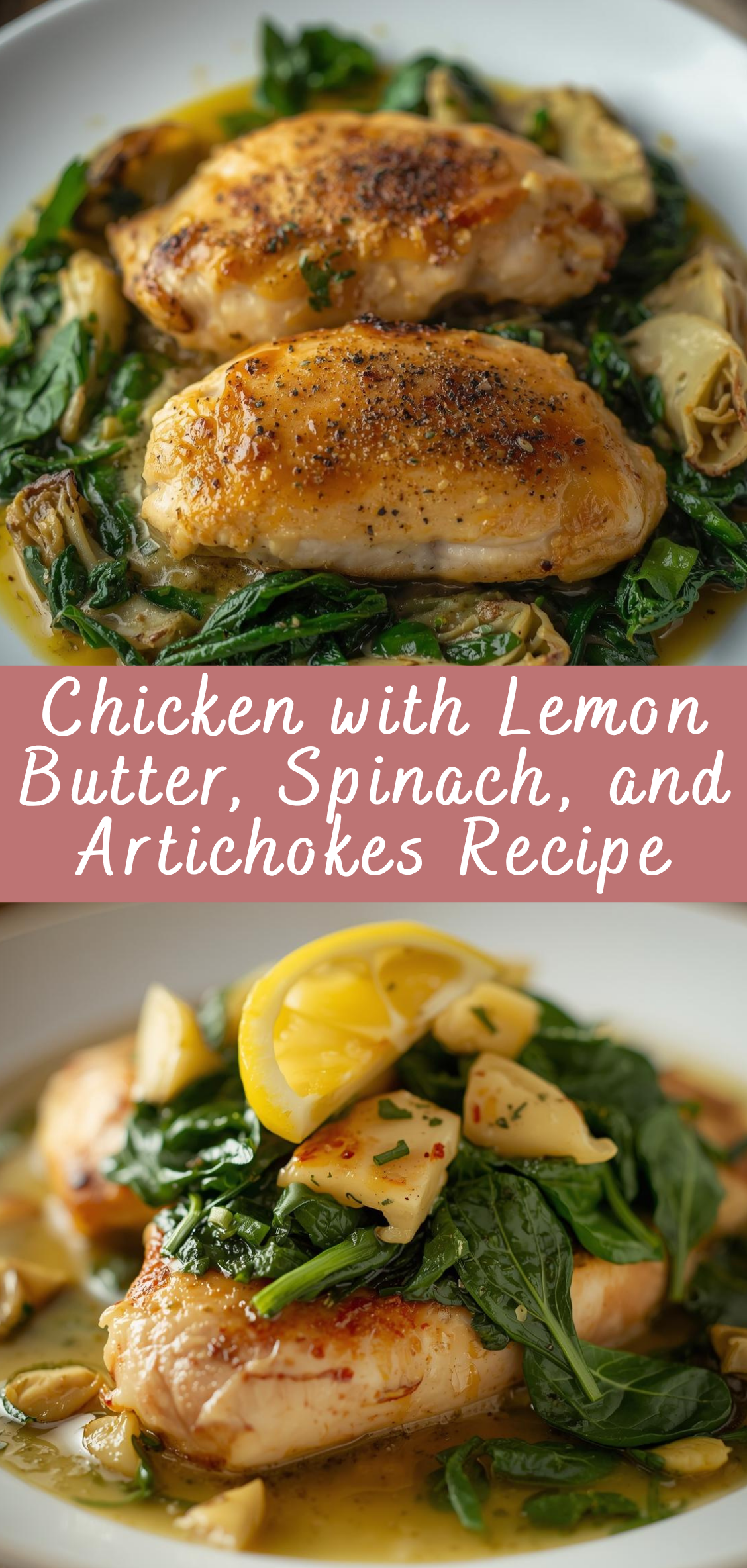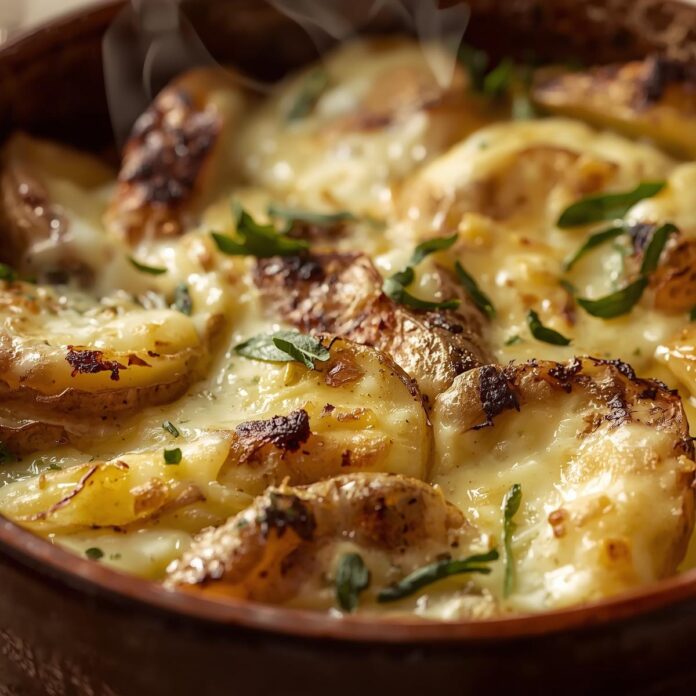Chicken with Lemon Butter, Spinach, and Artichokes Recipe: A Bright and Velvety One-Skillet Classic
Some dishes strike that rare balance between comfort and freshness, richness and restraint. Chicken with Lemon Butter, Spinach, and Artichokes is one of those dishes—a marriage of creamy indulgence and citrus brightness, rustic simplicity and refined flavor. The moment the sauce begins to shimmer in the pan, scented with garlic and lemon, you understand why this dish has become a modern classic: it is comfort food with elegance and lightness in every bite.

At its heart, this recipe is about contrast. The lemon butter sauce brings clarity and brightness that lifts the palate, cutting through the richness of the chicken and butter. The spinach offers color and freshness, a tender green note that softens into the sauce. The artichokes, with their subtle tang and layered flavor, lend a Mediterranean character—earthy, slightly floral, and deeply satisfying. Together, these ingredients form a complete and harmonious composition: savory, creamy, zesty, and beautifully balanced.
The dish draws inspiration from both Italian and French cooking traditions. From Italy, it borrows the sunlit flavor palette—lemon, artichoke, and spinach, ingredients that define the countryside from Tuscany to Sicily. From France, it inherits the silken touch of butter emulsified into pan juices, creating a sauce that glazes the chicken rather than smothering it. It’s a classic case of European culinary diplomacy on a plate, where simple ingredients—when handled with care—produce restaurant-quality sophistication.
What makes this recipe particularly special is its versatility and approachability. It’s a one-skillet meal, yet the flavors suggest hours of preparation. The chicken, seared until golden, develops a crisp exterior that locks in juiciness. As it simmers gently in the lemon butter sauce, it absorbs layers of flavor, becoming tender without losing its structure. Fresh spinach wilts just enough to retain its color and vitality, while marinated or canned artichokes blend their briny tang into the velvety sauce, enriching every mouthful. The finished dish is both hearty and light—a comforting meal that doesn’t weigh you down.
The lemon butter sauce deserves its own reverence. It’s deceptively simple: butter, garlic, lemon juice, and a touch of cream or broth. Yet, in its simplicity lies perfection. When the butter meets the heat and melds with the lemon, it transforms into a glossy, aromatic glaze that clings to each piece of chicken and greens. It’s a reminder that mastery in the kitchen often comes not from excess, but from precision and balance. Each ingredient is chosen for its voice in the harmony, not its volume.
Beyond its flavor, Chicken with Lemon Butter, Spinach, and Artichokes is a study in texture and color. The chicken offers golden crispness; the sauce, smooth richness; the spinach, a silky verdant contrast; and the artichokes, gentle tenderness that bridges the two. When plated, the dish gleams—a tableau of gold, green, and cream that looks as good as it tastes. A final squeeze of lemon and a scattering of herbs—perhaps parsley, thyme, or even a touch of dill—add the finishing notes of brightness and aroma.
This recipe is designed to be as educational as it is delicious. You’ll learn how to pan-sear chicken properly to build flavor, how to balance acidity with fat for a perfect sauce, and how to use ingredients like artichokes and spinach to bring complexity and color to a dish without overwhelming it. Each step will be broken down with precision and culinary reasoning, guiding you not just through the motions, but through the why behind them.
Whether you’re cooking for two or for a table full of guests, this dish offers the perfect blend of simplicity and elegance. It’s the kind of meal that invites conversation as it cooks—the sound of sizzling butter, the scent of garlic filling the air, the gleam of lemon zest catching the light. It’s food that comforts, delights, and feels alive with flavor.
In the sections that follow, we will explore the ingredients in depth—understanding how to choose the right type of chicken, why lemon behaves the way it does in a sauce, and how to coax the best flavor from artichokes. Then, we’ll move step-by-step through the cooking process, perfecting the golden sear, the emulsified sauce, and the final layering of spinach and herbs. By the end, you will not only have mastered this recipe but also gained insight into the art of balancing richness and brightness—the essence of great cooking.
So gather your skillet, sharpen your knife, and ready your lemons. The journey to creating Chicken with Lemon Butter, Spinach, and Artichokes begins here—with the promise of warmth, light, and flavor that feels like a Mediterranean breeze captured on a plate.
How to Make Chicken with Lemon Butter, Spinach, and Artichokes: Step-by-Step Instructions
At its best, this dish is a masterclass in balance — the golden sear of chicken, the silken brightness of lemon butter, and the gentle tang of artichokes softened by the earthy green of spinach.
It’s not complicated, but it requires attention, not speed. Each step builds flavor upon flavor, turning a few humble ingredients into something that tastes like a special occasion.
Below is a fully detailed process designed to ensure you achieve restaurant-quality results in your own kitchen.
Ingredients You Will Need
For the Chicken:
-
4 boneless, skinless chicken breasts (or 6 small chicken cutlets)
-
1 teaspoon salt
-
½ teaspoon black pepper
-
½ teaspoon paprika (optional, for color)
-
2 tablespoons all-purpose flour (for light dredging)
-
2 tablespoons olive oil
-
1 tablespoon unsalted butter
For the Sauce:
-
3 tablespoons unsalted butter (divided)
-
3 cloves garlic, minced or finely grated
-
½ cup (120 ml) dry white wine (or chicken broth, if avoiding alcohol)
-
Juice of 1 large lemon (about 3 tablespoons)
-
Zest of 1 lemon (finely grated)
-
¾ cup (180 ml) chicken broth (preferably low-sodium)
-
½ cup (120 ml) heavy cream (optional for a richer sauce)
-
¼ teaspoon red pepper flakes (optional, for a gentle warmth)
-
2 cups (60 g) fresh baby spinach
-
1 cup (170 g) marinated or canned artichoke hearts, quartered and drained
-
Salt and pepper, to taste
To Finish:
-
1 tablespoon fresh parsley, chopped
-
½ teaspoon thyme or oregano leaves (fresh preferred)
-
Lemon slices or wedges, for garnish
Essential Equipment
-
Large heavy skillet (cast iron or stainless steel preferred)
-
Tongs for turning chicken
-
Wooden spoon or spatula for stirring
-
Microplane or fine grater (for zesting)
-
Plate lined with paper towels (for resting the chicken)
Step 1: Preparing and Seasoning the Chicken
The foundation of the dish begins with well-prepared chicken. Whether you use breasts or cutlets, consistency in thickness is key. It ensures that each piece cooks evenly and stays tender.
-
Pound the Chicken (if needed):
Place each chicken breast between two pieces of plastic wrap or parchment. Using a meat mallet or the back of a skillet, gently pound to an even ½-inch thickness. This not only promotes even cooking but also tenderizes the meat without tearing it. -
Season Generously:
Pat the chicken dry with paper towels. Moisture prevents browning, and browning is the essence of flavor. Season both sides evenly with salt, pepper, and, if desired, a light dusting of paprika for color and warmth. -
Light Dredge (Optional but Recommended):
Lightly coat each piece in flour, shaking off the excess. This thin coating helps the chicken develop a crisp, golden crust and slightly thickens the sauce later as the flour mingles with butter and pan juices.
Step 2: Searing the Chicken
The sear is where flavor begins — that golden crust adds depth to both the chicken and the sauce.
-
Heat the Pan:
Place your skillet over medium-high heat and allow it to get hot. Add the olive oil and 1 tablespoon of butter. When the butter foams and begins to brown slightly, the pan is ready. -
Sear the Chicken:
Add the chicken to the skillet without overcrowding (work in batches if necessary). Let each piece sear undisturbed for 4–5 minutes until golden brown. Turn and cook for another 3–4 minutes on the other side.You’re not trying to cook the chicken fully at this point — just to lock in juices and develop that rich caramelized surface.
-
Rest and Reserve:
Transfer the seared chicken to a plate lined with paper towels. Tent loosely with foil to keep warm. The pan will have browned bits on the bottom — don’t clean them; they’re called fond and are the flavor base for your sauce.
Step 3: Building the Lemon Butter Sauce
The sauce is the soul of this dish — fragrant, buttery, and balanced between acidity and richness. It’s created in layers, not all at once.
-
Deglaze the Pan:
Reduce the heat to medium. Add 1 tablespoon of butter and the minced garlic. Sauté for 30 seconds, just until fragrant. Then pour in the white wine (or broth) and use a wooden spoon to scrape up the fond.
Let it simmer for 1–2 minutes, reducing slightly. -
Add Lemon and Broth:
Stir in the lemon juice, lemon zest, and chicken broth. The lemon should be fresh-squeezed; bottled juice lacks the brightness needed for this sauce. Simmer for another 2–3 minutes to let the flavors meld. -
Balance the Acidity:
Taste the sauce at this stage. It should be bright but not sharp. If too tart, add ½ teaspoon of sugar or a splash of cream. If too mild, add a bit more lemon juice. -
Add Optional Cream:
For a velvety, restaurant-style finish, stir in the heavy cream now. Let it simmer gently for 2–3 minutes until the sauce thickens slightly. Do not boil; boiling can cause the cream to split. -
Incorporate the Remaining Butter:
Reduce the heat to low and whisk in the final tablespoon of butter. This emulsifies the sauce, giving it a glossy, luxurious texture. Season to taste with salt, pepper, and red pepper flakes if desired.
Step 4: Adding Spinach and Artichokes
Now the sauce is ready to meet the vegetables that give this dish its color, character, and vibrancy.
-
Add the Artichokes:
Stir in the artichoke hearts. If using marinated ones, drain them well but don’t rinse — a little of their tangy oil enhances the sauce. Let them simmer for 2–3 minutes to warm through and absorb some of the lemon butter flavor. -
Add the Spinach:
Add the spinach in batches, stirring as it wilts. It may seem like too much at first, but spinach cooks down dramatically.
Stir gently until the leaves are tender and glossy, about 1–2 minutes. -
Check Consistency:
The sauce should be smooth and slightly thickened, coating the vegetables like silk. If it feels too thick, add a splash of broth; if too thin, simmer a minute longer uncovered.
Step 5: Returning the Chicken to the Pan
Now it’s time to reunite the chicken with the sauce — the final stage where everything comes together in harmony.
-
Nestle the Chicken:
Return the seared chicken pieces to the skillet, nestling them between the artichokes and spinach. Spoon some of the sauce over each piece to coat. -
Simmer Gently:
Lower the heat and let everything simmer for 5–7 minutes. This allows the chicken to finish cooking through while absorbing the flavors of lemon, butter, and garlic. -
Check for Doneness:
The internal temperature should reach 165°F (74°C). The sauce will now be thickened slightly, rich but still bright. -
Final Adjustments:
Taste and adjust seasoning one last time — a pinch of salt, a twist of black pepper, or a squeeze of fresh lemon can make all the difference.
Step 6: Finishing Touches and Garnish
This is where visual and aromatic appeal meet flavor refinement.
-
Add Fresh Herbs:
Sprinkle chopped parsley and thyme or oregano over the top. Their freshness contrasts beautifully with the buttery sauce. -
Garnish with Lemon:
Arrange thin lemon slices or wedges around the pan for brightness and presentation. A touch of zest grated just before serving enhances aroma. -
Optional Touch:
For a subtle elegance, drizzle a few drops of extra-virgin olive oil or add a pinch of grated Parmesan on top.
Step 7: Serving and Pairing
-
Serving Options:
-
Serve directly from the skillet for a rustic, inviting presentation.
-
Or plate the chicken individually, spooning the sauce and vegetables over the top.
-
-
Best Side Dishes:
-
Soft mashed potatoes or orzo pasta soak up the sauce perfectly.
-
Steamed rice, couscous, or crusty bread can also make simple but satisfying companions.
-
For a lighter pairing, serve with roasted asparagus or a crisp green salad.
-
Culinary Notes and Tips for Perfection
-
Balance is Key:
The success of this dish depends on the interplay of lemon and butter. Too much lemon, and the sauce becomes sour; too little, and it turns heavy. Always taste as you go. -
The Role of Browning:
The fond created by searing the chicken is crucial. It’s the flavor backbone of the sauce — never skip or rush this step. -
Cream or No Cream?
Traditional versions often skip the cream for a sharper, lighter sauce. Modern variations include cream for body and silkiness. Either works — choose based on your mood and menu. -
Artichoke Quality:
Marinated artichokes bring brine and complexity; canned artichokes are milder. If using fresh, steam them first until tender before adding to the sauce.
Chicken with Lemon Butter, Spinach, and Artichokes Recipe
Some dishes strike that rare balance between comfort and freshness, richness and restraint. Chicken with Lemon Butter, Spinach, and Artichokes is one of those dishes—a marriage of creamy indulgence and citrus brightness, rustic simplicity and refined flavor. The moment the sauce begins to shimmer in the pan, scented with garlic and lemon, you understand why this dish has become a modern classic: it is comfort food with elegance and lightness in every bite.
Ingredients
- For the chicken:
- 4 boneless, skinless chicken breasts (about 1½ lbs / 680 g total)
- Salt and freshly ground black pepper, to taste
- 2 Tbsp all-purpose flour (for dredging)
- 2 Tbsp olive oil
- 1 Tbsp butter
- For the sauce:
- 3 Tbsp unsalted butter
- 3 cloves garlic, minced
- ½ cup (120 ml) chicken broth
- ½ cup (120 ml) heavy cream (or half-and-half for lighter version)
- 2 Tbsp fresh lemon juice (plus zest of 1 lemon, optional)
- ½ cup (60 g) grated Parmesan cheese
- 1 (14 oz / 400 g) can artichoke hearts, drained and quartered
- 2 cups fresh baby spinach
- 1 Tbsp capers (optional, for extra tang)
- Fresh parsley, chopped (for garnish)
Instructions
- Prepare the chicken:
Pat chicken dry with paper towels. Season both sides with salt and pepper, then lightly dredge in flour, shaking off excess. - Sear the chicken:
Heat olive oil and 1 Tbsp butter in a large skillet over medium-high heat. Add chicken and cook for 4–5 minutes per side, or until golden and cooked through (internal temp 165°F / 74°C). Transfer to a plate and cover loosely with foil. - Make the sauce:
In the same skillet, reduce heat to medium. Add 3 Tbsp butter and minced garlic. Sauté until fragrant (about 30 seconds). - Deglaze:
Pour in chicken broth, scraping up any browned bits from the pan. Stir in heavy cream, lemon juice, and Parmesan cheese. Simmer for 2–3 minutes until slightly thickened. - Add vegetables:
Stir in artichoke hearts and spinach. Cook until spinach wilts, about 2 minutes. Add capers if using. - Combine and finish:
Return chicken to the skillet, spooning sauce over the top. Simmer together for 2–3 minutes so the flavors meld. - Serve:
Garnish with chopped parsley and a sprinkle of lemon zest. Serve warm over pasta, rice, or with crusty bread.
Notes
- Make it dairy-free: Use coconut cream and olive oil instead of butter and cream.
- Add heat: A pinch of red pepper flakes adds a nice kick.
- Extra lemon flavor: Finish with a squeeze of fresh lemon juice just before serving.
- Best sides: Serve with angel hair pasta, mashed potatoes, or roasted asparagus.



